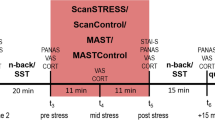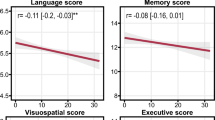Abstract
Catecholamines, including epinephrine (E), norepinephrine (NE), and dopamine (DA), are associated with the response to stressful conditions. However, the relationships of catecholamines with intelligence and their interactions with stress remain unclear. This study assessed stress, intelligence quotient (IQ), and catecholamine levels in 70 healthy subjects to elucidate associations between catecholamines and stress, and between catecholamines and IQ. Additionally, the associations of catecholamines with stress and IQ were analyzed according to hemispheric dominance using the Brain Preference Indicator (BPI). There were positive correlations between the NE/E ratio and the somatization of stress but negative correlations between the E/NE ratio and the somatization of stress among the total number of subjects. In the right-brain-dominant group, a high E/DA ratio was correlated with low levels of stress, somatization and depression, and high NE/E and DA/E ratios were associated with high levels of somatization. In the left-brain-dominant group, high E levels were correlated with low levels of depression. In the total subjects, there were positive correlations between the NE/E and DA/E ratios and the sum of the vocabulary, arithmetic, picture arrangement, and block design IQ subtests. Thus, these catecholamines were associated with stress and IQ, which suggests that the autonomic functional regulation of catecholamine levels in relation to stress may also affect cognitive functions related to intelligence in the brain. Furthermore, the relationships between catecholamines and stress or IQ differed depending on hemispheric dominance, which suggests that the present results could be used to inform the development of personalized therapies based on hemispheric asymmetry.





Similar content being viewed by others
References
Joh TH, Hwang O (1987) Dopamine beta-hydroxylase: biochemistry and molecular biology. Ann N Y Acad Sci 493:342–350
Wolf K, Zarkua G, Chan SA, Sridhar A, Smith C (2016) Spatial and activity-dependent catecholamine release in rat adrenal medulla under native neuronal stimulation. Physiol Rep 4:pii: e12898
Fuller RW (1982) Pharmacology of brain epinephrine neurons. Annu Rev Pharmacol Toxicol 22:31–55
Chrousos GP (2009) Stress and disorders of the stress system. Nat Rev Endocrinol 5:374–381
Winklewski PJ, Radkowski M, Wszedybyl-Winklewska M, Demkow U (2017) Stress response, brain noradrenergic system and cognition. Adv Exp Med Biol 980:67–74
Vargovic P, Ukropec J, Laukova M, Kurdiova T, Balaz M, Manz B, Ukropcova B, Kvetnansky R (2013) Repeated immobilization stress induces catecholamine production in rat mesenteric adipocytes. Stress 16:340–352
Tai TC, Claycomb R, Siddall BJ, Bell RA, Kvetnansky R, Wong DL (2007) Stress-induced changes in epinephrine expression in the adrenal medulla in vivo. J Neurochem 101:1108–1118
Wong DL, Tai TC, Wong-Faull DC, Claycomb R, Meloni EG, Myers KM, Carlezon WA Jr, Kvetnansky R (2012) Epinephrine: a short- and long-term regulator of stress and development of illness: a potential new role for epinephrine in stress. Cell Mol Neurobiol 32:737–748
Belujon P, Grace AA (2015) Regulation of dopamine system responsivity and its adaptive and pathological response to stress. Proc Biol Sci 282 pii:20142516
Vaessen T, Hernaus D, Myin-Germeys I, van Amelsvoort T (2015) The dopaminergic response to acute stress in health and psychopathology: a systematic review. Neurosci Biobehav Rev 56:241–251
Holly EN, Miczek KA (2016) Ventral tegmental area dopamine revisited: effects of acute and repeated stress. Psychopharmacology 233:163–186
Rodríguez de Lores Arnaiz G, Antonelli MC (2016) In search of concomitant alterations of dopaminergic and neurotensinergic systems in stress conditions. Neurochem Res 41:423–430
Pani L, Porcella A, Gessa GL (2000) The role of stress in the pathophysiology of the dopaminergic system. Mol Psychiatry 5:14–21
McEwen BS, Sapolsky RM (1995) Stress and cognitive function. Curr Opin Neurobiol 5:205–216
Clark KL, Noudoost B (2014) The role of prefrontal catecholamines in attention and working memory. Front Neural Circuits 8:33
Mather M, Harley CW (2016) The locus coeruleus: essential for maintaining cognitive function and the aging brain. Trends Cogn Sci 20:214–226
Nieoullon A (2002) Dopamine and the regulation of cognition and attention. Prog Neurobiol 67:53–83
Nieoullon A, Coquerel A (2003) Dopamine: a key regulator to adapt action, emotion, motivation and cognition. Curr Opin Neurol 16:S3–S9
Costanzo EY, Villarreal M, Drucaroff LJ, Ortiz-Villafañe M, Castro MN, Goldschmidt M, Wainsztein AE, Ladrón-de-Guevara MS, Romero C, Brusco LI, Camprodon JA, Nemeroff C, Guinjoan SM (2015) Hemispheric specialization in affective responses, cerebral dominance for language, and handedness: lateralization of emotion, language, and dexterity. Behav Brain Res 288:11–19
Gotts SJ, Jo HJ, Wallace GL, Saad ZS, Cox RW, Martin A (2013) Two distinct forms of functional lateralization in the human brain. Proc Natl Acad Sci U S A 110:E3435–E3444
Shen YQ, Hébert G, Moze E, Li KS, Neveu PJ (2005) Asymmetrical distribution of brain interleukin-6 depends on lateralization in mice. Neuroimmunomodulation 12:189–194
Herzog D, Killianova T, Pauwels S, Germeys F, Gidron Y (2016) Hemispheric lateralization moderates the life events-distress relationship. Stress Health 32:47–54
Sullivan RM (2004) Hemispheric asymmetry in stress processing in rat prefrontal cortex and the role of mesocortical dopamine. Stress 7:131–143
Esteves M, Marques P, Magalhães R, Castanho TC, Soares JM, Almeida A, Santos NC, Sousa N, Leite-Almeida H (2017) Structural laterality is associated with cognitive and mood outcomes: an assessment of 105 healthy aged volunteers. Neuroimage 153:86–96
Yeo RA, Turkheimer E, Raz N, Bigler ED (1987) Volumetric asymmetries of the human brain: intellectual correlates. Brain Cogn 6:15–23
Choi SM, Kang TY, Woo JM (2006) Development and validation of a modified form of the stress response inventory for workers. J Korean Neuropsychiatr Assoc 45:541–553
Koh KB, Park JK, Kim CH, Cho S (2001) Development of the stress response inventory and its application in clinical practice. Psychosom Med 63:668–678
Kaufman AS, Lichtenberger EO (2005) Assessing adolescent and adult intelligence, 3rd edn. Wiley, Hoboken (NJ), p 3
Lee YS, Kim ZS (1995) Validity of short forms of the Korean-Wechsler Adult Intelligence Scale. Korean J Clin Psychol 14:111–116
Wonder J, Donovan P (1984) Whole-brain thing. Quill, New York, pp 21–41
Bennun A (2010) Characterization of the norepinephrine-activation of adenylate cyclase suggests a role in memory affirmation pathways. Overexposure to epinephrine inactivates adenylate cyclase, a causal pathway for stress-pathologies. Biosystems 100:87–93
Lipowski ZJ (1988) Somatization: the concept and its clinical application. Am J Psychiatry 145:1358–1368
Gjerris A, Rafaelsen OJ, Christensen NJ (1987) CSF-adrenaline–low in “somatizing depression”. Acta Psychiatr Scand 75:516–520
Starkman MN, Cameron OG, Nesse RM, Zelnik T (1990) Peripheral catecholamine levels and the symptoms of anxiety: studies in patients with and without pheochromocytoma. Psychosom Med 52:129–142
Yoon BW, Morillo CA, Cechetto DF, Hachinski V (1997) Cerebral hemispheric lateralization in cardiac autonomic control. Arch Neurol 54:741–744
Wenzel JM, Rauscher NA, Cheer JF, Oleson EB (2015) A role for phasic dopamine release within the nucleus accumbens in encoding aversion: a review of the neurochemical literature. ACS Chem Neurosci 6:16–26
Holly EN, DeBold JF, Miczek KA (2015) Increased mesocorticolimbic dopamine during acute and repeated social defeat stress: modulation by corticotropin releasing factor receptors in the ventral tegmental area. Psychopharmacology 232:4469–4479
Sullivan RM, Szechtman H (1995) Asymmetrical influence of mesocortical dopamine depletion on stress ulcer development and subcortical dopamine systems in rats: implications for psychopathology. Neuroscience 65:757–766
Charney DS, Heninger GR, Sternberg DE, Hafstad KM, Giddings S, Landis DH (1982) Adrenergic receptor sensitivity in depression. Effects of clonidine in depressed patients and healthy subjects. Arch Gen Psychiatry 39:290–294
Stone EA, Lin Y, Rosengarten H, Kramer HK, Quartermain D (2003) Emerging evidence for a central epinephrine-innervated alpha 1-adrenergic system that regulates behavioral activation and is impaired in depression. Neuropsychopharmacology 28:1387–1399
Cools R (2016) The costs and benefits of brain dopamine for cognitive control. Wiley Interdiscip Rev Cogn Sci 7:317–329
Kolata S, Light K, Wass CD, Colas-Zelin D, Roy D, Matzel LD (2010) A dopaminergic gene cluster in the prefrontal cortex predicts performance indicative of general intelligence in genetically heterogeneous mice. PLoS ONE 5:e14036
Puig MV, Antzoulatos EG, Miller EK (2014) Prefrontal dopamine in associative learning and memory. Neuroscience 282:217–229
Lapiz MD, Morilak DA (2006) Noradrenergic modulation of cognitive function in rat medial prefrontal cortex as measured by attentional set shifting capability. Neuroscience 137:1039–1049
Monchi O, Ko JH, Strafella AP (2006) Striatal dopamine release during performance of executive functions: a [(11)C] raclopride PET study. Neuroimage 33:907–912
Ko JH, Monchi O, Ptito A, Bloomfield P, Houle S, Strafella AP (2008) Theta burst stimulation-induced inhibition of dorsolateral prefrontal cortex reveals hemispheric asymmetry in striatal dopamine release during a set-shifting task: a TMS-[(11)C]raclopride PET study. Eur J Neurosci 28:2147–2155
Huang YZ, Edwards MJ, Rounis E, Bhatia KP, Rothwell JC (2005) Theta burst stimulation of the human motor cortex. Neuron 45:201–206
Nowak G (1989) Lateralization of neocortical dopamine receptors and dopamine level in normal Wistar rats. Pol J Pharmacol Pharm 41:133–137
Sørensen JG, Vermeulen CJ, Flik G, Loeschcke V (2009) Stress specific correlated responses in fat content, Hsp70 and dopamine levels in Drosophila melanogaster selected for resistance to environmental stress. J Insect Physiol 55:700–706
Cahill L, Alkire MT (2003) Epinephrine enhancement of human memory consolidation: interaction with arousal at encoding. Neurobiol Learn Mem 79:194–198
Elwood SW, Ferguson HB, Thakar J (1986) Catecholamine response of children in a naturally occurring stressor situation. J Human Stress 12:154–161
Rothman KJ (1990) No adjustments are needed for multiple comparisons. Epidemiology 1:43–46
Saville DJ (1990) Multiple comparison procedures: the practical solution. Am Stat 44:174–180
Maas JW (1984) Relationships between central nervous system noradrenergic function and plasma and urinary concentrations of norepinephrine metabolites. Adv Biochem Psychopharmacol 39:45–55
Barbeau A, Murphy GF, Sourkes TL (1961) Excretion of dopamine in diseases of basal ganglia. Science 133:1706–1707
Acknowledgements
The authors wish to thank all participants for their valuable time engaging with this research. This research was supported by the Brain Research Program through the National Research Foundation of Korea (NRF) funded by the Ministry of Science, ICT & Future Planning (NRF-2016M3C7A1914449).
Author information
Authors and Affiliations
Corresponding authors
Ethics declarations
Competing Interests
The authors declare no competing interests.
Additional information
Publisher’s Note
Springer Nature remains neutral with regard to jurisdictional claims in published maps and institutional affiliations.
Rights and permissions
About this article
Cite this article
Jung, YH., Jang, J.H., Lee, D. et al. Relationships Between Catecholamine Levels and Stress or Intelligence. Neurochem Res 44, 1192–1200 (2019). https://doi.org/10.1007/s11064-019-02762-z
Received:
Revised:
Accepted:
Published:
Issue Date:
DOI: https://doi.org/10.1007/s11064-019-02762-z




